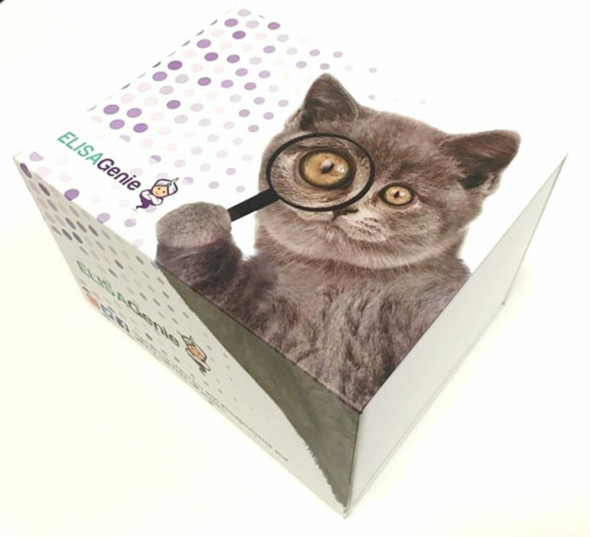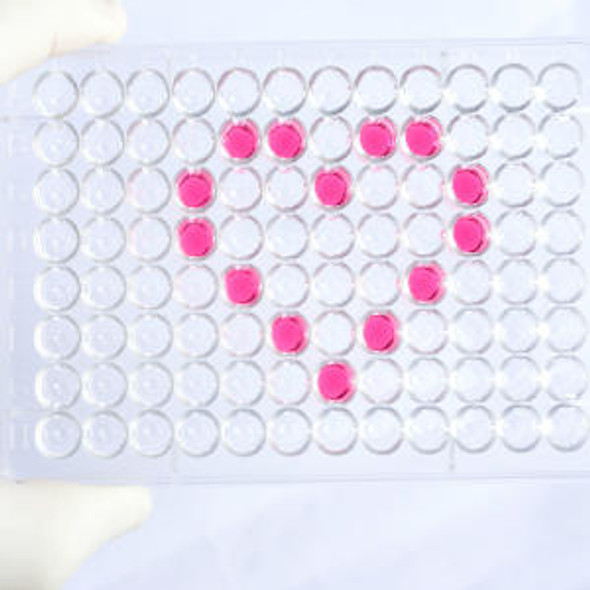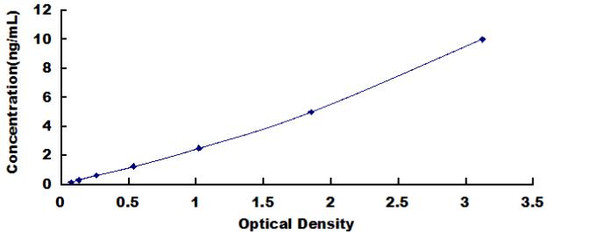Human Cell Death ELISA Kits
Human CASP1 (Caspase 1) CLIA Kit (HUES00016)
- SKU:
- HUES00016
- Product Type:
- ELISA Kit
- ELISA Type:
- CLIA Kit
- Size:
- 96 Assays
- Sensitivity:
- 3.75pg/mL
- Range:
- 6.25-400pg/mL
- ELISA Type:
- Sandwich
- Synonyms:
- ICE, IL1BC, P45, Interleukin 1 Beta Converting Enzyme, Apoptosis-Related Cysteine Peptidase
- Reactivity:
- Human
- Sample Type:
- Serum, plasma and other biological fluids
- Research Area:
- Cell Death
Description
| Assay type: | Sandwich |
| Format: | 96T |
| Assay time: | 4.5h |
| Reactivity: | Human |
| Detection method: | Chemiluminescence |
| Detection range: | 6.25-400 pg/mL |
| Sensitivity: | 3.75 pg/mL |
| Sample volume: | 100µL |
| Sample type: | Serum, plasma and other biological fluids |
| Repeatability: | CV < 15% |
| Specificity: | This kit recognizes Human CASP1 in samples. No significant cross-reactivity or interference between Human CASP1 and analogues was observed. |
This kit uses Sandwich-CLIA as the method. The micro CLIA plate provided in this kit has been pre-coated with an antibody specific to Human CASP1. Standards or samples are added to the appropriate micro CLIA plate wells and combined with the specific antibody. Then a biotinylated detection antibody specific for Human CASP1 and Avidin-Horseradish Peroxidase (HRP) conjugate are added to each micro plate well successively and incubated. Free components are washed away. The substrate solution is added to each well. Only those wells that contain Human CASP1, biotinylated detection antibody and Avidin-HRP conjugate will appear fluorescence. The Relative light unit (RLU) value is measured spectrophotometrically by the Chemiluminescence immunoassay analyzer. The RLU value is positively associated with the concentration of Human CASP1. The concentration of Human CASP1 in the samples can be calculated by comparing the RLU of the samples to the standard curve.
| UniProt Protein Function: | CASP1: Thiol protease that cleaves IL-1 beta between an Asp and an Ala, releasing the mature cytokine which is involved in a variety of inflammatory processes. Important for defense against pathogens. Cleaves and activates sterol regulatory element binding proteins (SREBPs). Can also promote apoptosis. Heterotetramer that consists of two anti-parallel arranged heterodimers, each one formed by a 20 kDa (p20) and a 10 kDa (p10) subunit. The p20 subunit can also form a heterodimer with the epsilon isoform which then has an inhibitory effect. May be a component of the inflammasome, a protein complex which also includes PYCARD, CARD8 and NALP2 and whose function would be the activation of proinflammatory caspases. Interacts with CARD17/INCA and CARD18. Expressed in larger amounts in spleen and lung. Detected in liver, heart, small intestine, colon, thymus, prostate, skeletal muscle, peripheral blood leukocytes, kidney and testis. No expression in the brain. Specifically inhibited by the cowpox virus Crma protein. Belongs to the peptidase C14A family. 5 isoforms of the human protein are produced by alternative splicing. |
| UniProt Protein Details: | Protein type:Apoptosis; Protease; EC 3. 4. 22. 36 Chromosomal Location of Human Ortholog: 11q23 Cellular Component: cytoplasm; extracellular region; cytosol Molecular Function:protein binding; cysteine-type endopeptidase activity; endopeptidase activity; caspase activator activity Biological Process: caspase activation; positive regulation of I-kappaB kinase/NF-kappaB cascade; apoptosis; membrane hyperpolarization; interleukin-1 beta production; response to lipopolysaccharide; positive regulation of interleukin-1 beta secretion; mitochondrial depolarization; proteolysis; signal transduction; response to ATP; positive regulation of interleukin-1 alpha secretion; regulation of inflammatory response; response to hypoxia; innate immune response; regulation of autophagy |
| NCBI Summary: | This gene encodes a protein which is a member of the cysteine-aspartic acid protease (caspase) family. Sequential activation of caspases plays a central role in the execution-phase of cell apoptosis. Caspases exist as inactive proenzymes which undergo proteolytic processing at conserved aspartic residues to produce 2 subunits, large and small, that dimerize to form the active enzyme. This gene was identified by its ability to proteolytically cleave and activate the inactive precursor of interleukin-1, a cytokine involved in the processes such as inflammation, septic shock, and wound healing. This gene has been shown to induce cell apoptosis and may function in various developmental stages. Studies of a similar gene in mouse suggest a role in the pathogenesis of Huntington disease. Alternative splicing results in transcript variants encoding distinct isoforms. [provided by RefSeq, Mar 2012] |
| UniProt Code: | P29466 |
| NCBI GenInfo Identifier: | 266321 |
| NCBI Gene ID: | 834 |
| NCBI Accession: | P29466. 1 |
| UniProt Secondary Accession: | P29466,Q53EY6, Q6DMQ1, Q6GSS3, Q6PI75, Q9UCN3, B5MDZ1 |
| UniProt Related Accession: | P29466 |
| Molecular Weight: | 10,417 Da |
| NCBI Full Name: | Caspase-1 |
| NCBI Synonym Full Names: | caspase 1, apoptosis-related cysteine peptidase |
| NCBI Official Symbol: | CASP1 |
| NCBI Official Synonym Symbols: | ICE; P45; IL1BC |
| NCBI Protein Information: | caspase-1; IL1B-convertase; CASP1 nirs variant 1; IL-1 beta-converting enzyme; interleukin 1, beta, convertase; interleukin 1-B converting enzyme; caspase 1, apoptosis-related cysteine peptidase (interleukin 1, beta, convertase) |
| UniProt Protein Name: | Caspase-1 |
| UniProt Synonym Protein Names: | Interleukin-1 beta convertase; IL-1BC; Interleukin-1 beta-converting enzyme; ICE; IL-1 beta-converting enzyme; p45Cleaved into the following 2 chains:Caspase-1 subunit p20; Caspase-1 subunit p10 |
| UniProt Gene Name: | CASP1 |
| UniProt Entry Name: | CASP1_HUMAN |
As the RLU values of the standard curve may vary according to the conditions of the actual assay performance (e. g. operator, pipetting technique, washing technique or temperature effects), the operator should establish a standard curve for each test. Typical standard curve and data is provided below for reference only.
| Concentration (pg/mL) | RLU | Average | Corrected |
| 400 | 48076 48342 | 48209 | 48172 |
| 200 | 18398 20248 | 19323 | 19286 |
| 100 | 8942 8170 | 8556 | 8519 |
| 50 | 3815 4367 | 4091 | 4054 |
| 25 | 2201 1975 | 2088 | 2051 |
| 12.5 | 1162 1126 | 1144 | 1107 |
| 6.25 | 654 720 | 687 | 650 |
| 0 | 36 38 | 37 | -- |
Precision
Intra-assay Precision (Precision within an assay): 3 samples with low, mid range and high level Human CASP1 were tested 20 times on one plate, respectively.
Inter-assay Precision (Precision between assays): 3 samples with low, mid range and high level Human CASP1 were tested on 3 different plates, 20 replicates in each plate.
| Intra-assay Precision | Inter-assay Precision | |||||
| Sample | 1 | 2 | 3 | 1 | 2 | 3 |
| n | 20 | 20 | 20 | 20 | 20 | 20 |
| Mean (pg/mL) | 18.81 | 49.91 | 189.93 | 18.27 | 45.54 | 182.67 |
| Standard deviation | 1.63 | 5.07 | 16.77 | 1.79 | 5.41 | 19.55 |
| C V (%) | 8.67 | 10.16 | 8.83 | 9.80 | 11.88 | 10.70 |
Recovery
The recovery of Human CASP1 spiked at three different levels in samples throughout the range of the assay was evaluated in various matrices.
| Sample Type | Range (%) | Average Recovery (%) |
| Serum (n=5) | 91-105 | 96 |
| EDTA plasma (n=5) | 90-104 | 97 |
| Cell culture media (n=5) | 93-106 | 101 |
Linearity
Samples were spiked with high concentrations of Human CASP1 and diluted with Reference Standard & Sample Diluent to produce samples with values within the range of the assay.
| Serum (n=5) | EDTA plasma (n=5) | Cell culture media (n=5) | ||
| 1:2 | Range (%) | 89-102 | 97-112 | 100-114 |
| Average (%) | 95 | 103 | 106 | |
| 1:4 | Range (%) | 86-96 | 86-96 | 94-108 |
| Average (%) | 91 | 91 | 100 | |
| 1:8 | Range (%) | 92-103 | 98-111 | 95-107 |
| Average (%) | 97 | 104 | 101 | |
| 1:16 | Range (%) | 86-96 | 84-100 | 90-101 |
| Average (%) | 91 | 91 | 95 |
An unopened kit can be stored at 4°C for 1 month. If the kit is not used within 1 month, store the items separately according to the following conditions once the kit is received.
| Item | Specifications | Storage |
| Micro CLIA Plate(Dismountable) | 8 wells ×12 strips | -20°C, 6 months |
| Reference Standard | 2 vials | |
| Concentrated Biotinylated Detection Ab (100×) | 1 vial, 120 µL | |
| Concentrated HRP Conjugate (100×) | 1 vial, 120 µL | -20°C(shading light), 6 months |
| Reference Standard & Sample Diluent | 1 vial, 20 mL | 4°C, 6 months |
| Biotinylated Detection Ab Diluent | 1 vial, 14 mL | |
| HRP Conjugate Diluent | 1 vial, 14 mL | |
| Concentrated Wash Buffer (25×) | 1 vial, 30 mL | |
| Substrate Reagent A | 1 vial, 5 mL | 4°C (shading light) |
| Substrate Reagent B | 1 vial, 5 mL | 4°C (shading light) |
| Plate Sealer | 5 pieces | |
| Product Description | 1 copy | |
| Certificate of Analysis | 1 copy |
- Set standard, test sample and control (zero) wells on the pre-coated plate and record theirpositions. It is recommended to measure each standard and sample in duplicate. Note: addall solutions to the bottom of the plate wells while avoiding contact with the well walls. Ensuresolutions do not foam when adding to the wells.
- Aliquot 100µl of standard solutions into the standard wells.
- Add 100µl of Sample / Standard dilution buffer into the control (zero) well.
- Add 100µl of properly diluted sample (serum, plasma, tissue homogenates and otherbiological fluids. ) into test sample wells.
- Cover the plate with the sealer provided in the kit and incubate for 90 min at 37°C.
- Aspirate the liquid from each well, do not wash. Immediately add 100µL of BiotinylatedDetection Ab working solution to each well. Cover the plate with a plate seal and gently mix. Incubate for 1 hour at 37°C.
- Aspirate or decant the solution from the plate and add 350µL of wash buffer to each welland incubate for 1-2 minutes at room temperature. Aspirate the solution from each well andclap the plate on absorbent filter paper to dry. Repeat this process 3 times. Note: a microplatewasher can be used in this step and other wash steps.
- Add 100µL of HRP Conjugate working solution to each well. Cover with a plate seal andincubate for 30 min at 37°C.
- Aspirate or decant the solution from each well. Repeat the wash process for five times asconducted in step 7.
- Add 100µL of Substrate mixture solution to each well. Cover with a new plate seal andincubate for no more than 5 min at 37°C. Protect the plate from light.
- Determine the RLU value of each well immediately.






